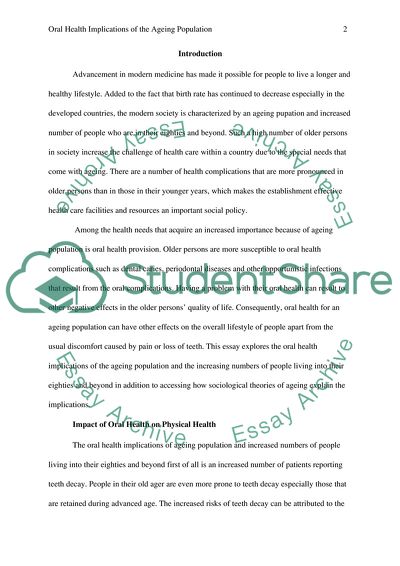Cite this document
(Oral Health Implications of the Ageing Population Report Example | Topics and Well Written Essays - 3500 words, n.d.)
Oral Health Implications of the Ageing Population Report Example | Topics and Well Written Essays - 3500 words. https://studentshare.org/sociology/1815677-what-are-the-oral-health-implications-of-the-ageing-population-and-the-increasing-numbers-of-people-living-into-their-80s-and-beyond-and-how-might-sociological-theories-of-ageing-help-to-explain-theses-implications
Oral Health Implications of the Ageing Population Report Example | Topics and Well Written Essays - 3500 words. https://studentshare.org/sociology/1815677-what-are-the-oral-health-implications-of-the-ageing-population-and-the-increasing-numbers-of-people-living-into-their-80s-and-beyond-and-how-might-sociological-theories-of-ageing-help-to-explain-theses-implications
(Oral Health Implications of the Ageing Population Report Example | Topics and Well Written Essays - 3500 Words)
Oral Health Implications of the Ageing Population Report Example | Topics and Well Written Essays - 3500 Words. https://studentshare.org/sociology/1815677-what-are-the-oral-health-implications-of-the-ageing-population-and-the-increasing-numbers-of-people-living-into-their-80s-and-beyond-and-how-might-sociological-theories-of-ageing-help-to-explain-theses-implications.
Oral Health Implications of the Ageing Population Report Example | Topics and Well Written Essays - 3500 Words. https://studentshare.org/sociology/1815677-what-are-the-oral-health-implications-of-the-ageing-population-and-the-increasing-numbers-of-people-living-into-their-80s-and-beyond-and-how-might-sociological-theories-of-ageing-help-to-explain-theses-implications.
“Oral Health Implications of the Ageing Population Report Example | Topics and Well Written Essays - 3500 Words”. https://studentshare.org/sociology/1815677-what-are-the-oral-health-implications-of-the-ageing-population-and-the-increasing-numbers-of-people-living-into-their-80s-and-beyond-and-how-might-sociological-theories-of-ageing-help-to-explain-theses-implications.


